As
one of the countries leading dealers
in patented and mechanical antiques we are always interestedin
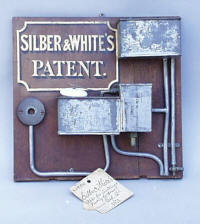 buying patent models,
antique salesman samples, and other detailed models related to
those categories of antiques that we specialize in.
buying patent models,
antique salesman samples, and other detailed models related to
those categories of antiques that we specialize in.
Patent Models
were submitted to the US Government Patent office for review of the inventor's idea.
If you have or know of some that may be of interest to us, please let
us know by contacting us at
AntiqBuyer@gmail.com with as many details as possible.
What antique & vintage patent models
or salesman samples we currently have for sale can be found on our antique sales website
www.Patented-Antiques.com
Patent Model History & Examples
The idea for the requirement of a model of a given
invention or idea was first authorized by the US Government in 1790. These
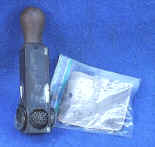 models of the inventor's idea
came to be known as Patent Models. The process changed over
the next few years, and evolved to where in approximately 1836
every idea or invention that was to be patented had to have an accompanying model that was to be no larger than 12" x 12" square.
models of the inventor's idea
came to be known as Patent Models. The process changed over
the next few years, and evolved to where in approximately 1836
every idea or invention that was to be patented had to have an accompanying model that was to be no larger than 12" x 12" square.
The numbering system for patent models began on in 1836 with #1. Earlier models were given what is known as an X number to
denote those that were already in existence. There was little
record keeping of these earlier models, and at about this same time the first of 2 major fires destroyed
most of the known patent models that had been submitted that were being stored
in a warehouse.
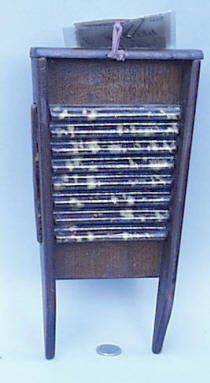 Even though Congress authorized the rebuilding of select models, this
explains why very few early models from before this period are known.
Even though Congress authorized the rebuilding of select models, this
explains why very few early models from before this period are known.
Models of the patented idea were a requirement up into the 1880's or so.
Because of the sheer volume of patent models already in their possession
and the volume of new models that were arriving daily, the requirement was dropped
and modified. By 1880 the requirement for a model was changed
to where they were only to be submitted when required by the commissioner.
At this point there
were over 200,000 models in the government's possession.
At
about this time a second fire hit the Patent Office buildings housing the
collection and many more of the models were again destroyed and damaged by
fire. Many of the models found today are damaged or show the effects of
water and smoke from this fire.
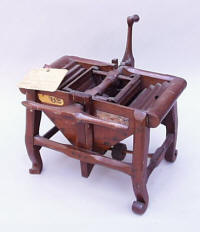 A lot of these patent models are now being sold
/ peddled on eBay with new fake tags and a story about the proceeds being
for some charitable foundation.
A lot of these patent models are now being sold
/ peddled on eBay with new fake tags and a story about the proceeds being
for some charitable foundation.
In 1908 the government decided to sell off the remaining patent models. After giving
some back to original patentees or to their families, and after the
Smithsonian took those that they deemed historically significant,
the remainder were finally sold off in 1925 to the first of
many entrepreneurs with a vision for their potential.
The underbidders of this first
sale were buyers from
Japan whose intention was to scrap them for their value as scrap / metal weight.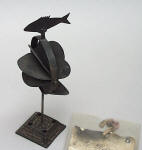
Luckily for the American collectors this did not happen. Over the
next few years the remaining patent models changed hands several times after attempts
to form museums or to sell them failed for one reason or another.
The models were moved a couple of times and batches of them sold a couple
more times. Small batches were always coming onto the market
for sale as each new owner tried his hand at properly promoting them. At different times they were sold from kiosks on street corners or in
department stores in New York. They were also offered through
catalog sales in the 70's. In the early 90's there were a couple of auctions
of Patent Models in New York at Christies auction house.
The final sale of the remaining stock was sold just a few years ago, and
again the hope, or claim was to form a museum around the remaining examples that were
purchased. I have since heard that plan is no longer in the works either.
The good news is that, although hard to find, there are literally
thousands of these models out and about - around the
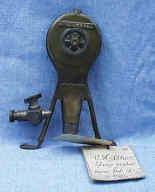 country. The most interesting feature to consider is that no two are
alike, and each and every one of them is a unique creation. Some are
intricate, some are very simple, but all display the sense of the American
spirit and ethic, thus making for one of the greatest of all collectibles
available to the American collector who has interests in history, art,
form, and the mechanical intricacies that are involved in many of these
models.
country. The most interesting feature to consider is that no two are
alike, and each and every one of them is a unique creation. Some are
intricate, some are very simple, but all display the sense of the American
spirit and ethic, thus making for one of the greatest of all collectibles
available to the American collector who has interests in history, art,
form, and the mechanical intricacies that are involved in many of these
models.
On the left
is a Water Motor patent model from 1881. The idea behind this device was that a standard
water motor could be
improved on by adding a provision for injecting an auxiliary jet of steam
or other gaseous material to the mix to increase the efficiency of the
motor. It was good enough an idea to get Mr. Atwell a patent, but it seems that the
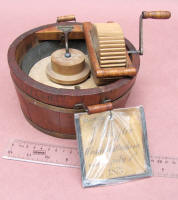 ideas for different designs of water motors put forth by names such as Pelton, Dodd, and others were better received in the marketplace
as I have seen examples of those water motors numerous times, but never a device quite like this one.
ideas for different designs of water motors put forth by names such as Pelton, Dodd, and others were better received in the marketplace
as I have seen examples of those water motors numerous times, but never a device quite like this one.
We have more examples of Patent models for sale and pictured at our sales site
www.Patented-Antiques.com .
What I have shown you on this page is just a small sampling to give you an
idea of how interesting and historically significant these models can be.
If you would like to see examples of past
sales results for other antique Patent Models
go to this link
Patent Model Results For any of the
other Past Sales archives click the appropriate links in the right hand
column.
The examples of patent models discussed and shown are of the caliber, condition
and quality of patent models or salesman samples that we are interested in buying.
If you have quality antique or
vintage Patent Models or salesman samples that you want to sell, please contact us at
AntiqBuyer@gmail.com providing as many details as possible.
To see examples of antique patent models
and salesman samplesI currently have for sale please go to our sister site
at www.Patented-Antiques.com and
visit the sale pages you will find there.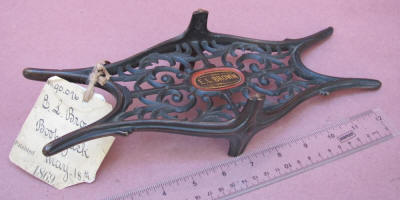
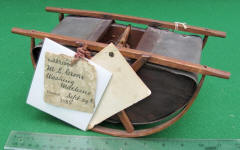 Thank you!!
Thank you!!
Larry & Carole